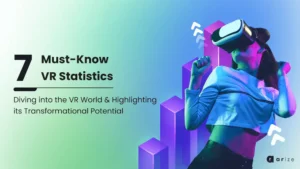There has been a steady increase in the role augmented reality plays in our daily lives, especially in how we communicate.
While we have visions of AR being futuristic gadgets like HUD contact lenses, and holographic imaging, mass consumer AR adoption in communication began with messaging.
If you’ve ever used a Snapchat filter or a lens on Instagram, you are participating in communication through AR technology. It might seem trivial, as we use them every day, but it was a pivotal moment where digital and actual reality were merged on a mass scale.
Right now, we are in the midst of even more revolutionary growth in AR that will evolve our methods of communication even further.
One of the reasons for using AR to convey a message is that it adds new layers of meaning; visuals add meaning to the text, and motion brings new depth to visuals.
Movement tends to heighten responses in three crucial areas:
Visual – AR is innately visual, and effective storytelling leverages this advantage.
Emotional – Immersion leads to deeper emotional connections.
Personal – AR lets users focus on what interests them personally, connecting with consumers and speaking more clearly to them.
So how is AR changing the face of communication? There are many different aspects in many other forums, but here are some of the significant ways it is changing communication in our everyday life:
Virtual Backgrounds and Face Filters
The pandemic led to the mass adoption of remote working and living. People got used to working, learning, and socializing over video conferencing, resulting in the rise of apps like Zoom, Google Hangouts, and Microsoft Teams.
Over time this led to what became known as “Zoom Fatigue” while being on calls for an extended period or numerous occasions, while many also felt uncomfortable about showing themselves and their surroundings.
Virtual backgrounds proved part of the solution, allowing participants to make their calls more interactive and enjoyable while keeping their environment private.
Another helpful feature is the face filters. This can range from sitting in a meeting looking like a cat or a panda to facial touch-ups such as skin smoothing, teeth whitening, and professional lighting.
Looking good in front of the camera has given people more confidence and helped to propagate the rise of video conferencing even after lockdown.
Virtual Try Ons
Many businesses took advantage of live-streaming AR in 2020 to communicate with their customers by showing their latest products.
It offers several advantages; it is more personal and public-facing, gives you a wider reach than any in-person event, and, thirdly, users can now take advantage of virtual try-on technology.
While watching a live stream, users can click a button and see how a product looks on them while still watching the live stream. Unlike Instagram and Snapchat, these filters give a very natural look and can help inform purchasing decisions.
AR Avatars
With the increased demand for personal privacy, and the desire to make their presence more personalized and unique, the demand for AR avatars is growing.
In Japan, over 4,000 virtual YouTubers prefer to use a digital version in the form of an avatar rather than facing the camera themselves.
Twitch users can take advantage of a virtual makeover with Snap’s AR effects, allowing them to be creative while doing live streams of their favorite games and other content.
So, What Does This Mean?
It feels like these developments are just part of a larger movement that will reshape world communication, and the question is, who will lead the AR revolution?
AR can overcome language barriers and different abilities and will allow for a mode of connection that we haven’t even fully begun to understand. So, the next time you try out a new face filter, you’re not just messing about. You’re helping to shape the future.



